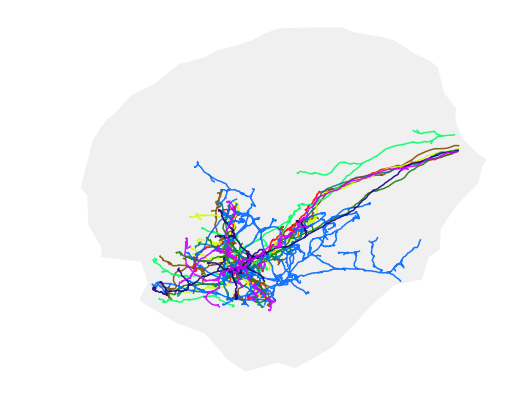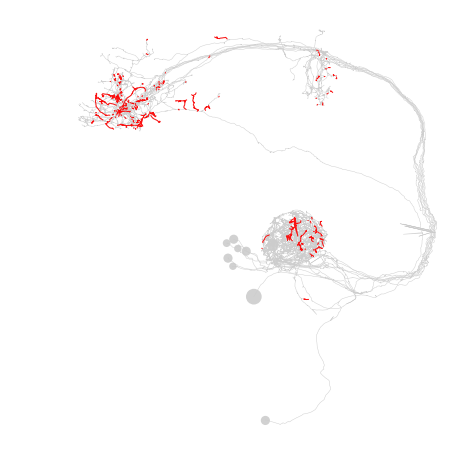Calculating user contributions¶
When gearing up for publication, you will find that due to the collaborative approach of CATMAID a great many people will have contributed to the data you would like to publish. In order to come up with a sensible author list, it is useful to quantify how much a user has contributed to the reconstruction of a set of neurons. CATMAID provides you a broad summary of contributions e.g. via the selection table. Pymaid let’s you fetch that data and more.
First, let’s get a set of olfactory projection neurons to demonstrate user statistics on:
[1]:
import pymaid
# Initialize connection
rm = pymaid.connect_catmaid()
# Fetch some neurons
nl = pymaid.get_neurons('annotation:glomerulus DA1 right')
INFO : Found 9 skeletons with matching annotation(s) (pymaid)
First some basic stats:
[2]:
cont = pymaid.get_contributor_statistics(nl, separate=True)
cont.head()
[2]:
| skeleton_id | n_nodes | node_contributors | n_presynapses | pre_contributors | n_postsynapses | post_contributors | review_contributors | multiuser_review_minutes | construction_minutes | min_review_minutes | |
|---|---|---|---|---|---|---|---|---|---|---|---|
| 0 | 61221 | 7875 | {'adamjohn': 2442, 'ranftp': 4109, 'ratliffj':... | 404 | {'hsuj': 1, 'adamjohn': 10, 'ranftp': 249, 'ha... | 128 | {'ranftp': 89, 'alij': 1, 'koppenhaverb': 5, '... | {'ratliffj': 2834, 'masoodpanahn': 84, 'koppen... | 165 | 416 | 135 |
| 1 | 27295 | 9975 | {'koppenhaverb': 102, 'robertsr': 53, 'lovef':... | 412 | {'robertsr': 32, 'alij': 6, 'schlegelp': 205, ... | 59 | {'alij': 2, 'heatha': 2, 'hallouc': 2, 'schleg... | {'schlegelp': 517, 'adesinaa': 2586, 'kmecoval... | 367 | 502 | 313 |
| 2 | 57323 | 4585 | {'kmecoval': 2194, 'robertsr': 159, 'koppenhav... | 361 | {'calles': 2, 'michaelLingelbach': 1, 'kmecova... | 76 | {'vallas': 1, 'ranftp': 1, 'edmondsona': 20, '... | {'ratliffj': 2116, 'kmecoval': 350, 'masoodpan... | 176 | 208 | 84 |
| 3 | 57311 | 4882 | {'kmecoval': 1376, 'robertsr': 24, 'lovef': 75... | 371 | {'robertsr': 18, 'lovef': 220, 'jamasba': 4, '... | 58 | {'robertsr': 10, 'ranftp': 1, 'heatha': 1, 'lo... | {'mooree': 2308, 'adamjohn': 1231, 'kmecoval':... | 390 | 241 | 163 |
| 4 | 57353 | 4898 | {'kmecoval': 1054, 'hsuj': 1, 'koppenhaverb': ... | 302 | {'hsuj': 1, 'robertsr': 13, 'kmecoval': 17, 's... | 24 | {'robertsr': 7, 'kmecoval': 2, 'meechank': 13,... | {'adamjohn': 1843, 'sharifin': 1231, 'masoodpa... | 177 | 247 | 101 |
For convencience, there is another function that shows contributions per-user instead of per-neuron:
[3]:
by_user = pymaid.get_user_contributions(nl)
by_user.head()
[3]:
| user | nodes | presynapses | postsynapses | nodes_reviewed | |
|---|---|---|---|---|---|
| 0 | robertsr | 14527 | 1038 | 481 | 4729 |
| 1 | ranftp | 5927 | 401 | 132 | 0 |
| 2 | kmecoval | 5204 | 87 | 4 | 5177 |
| 3 | hallouc | 4267 | 61 | 11 | 8047 |
| 4 | michaelLingelbach | 4253 | 1 | 0 | 0 |
Sometimes the plain number of nodes (or cable length) are not very helpful. Did a person trace mostly backbone (fast) or did they scramble tracing fine terminal branches (slow)? Personally, I consider time invested to be a better metric:
[4]:
time_inv = pymaid.get_time_invested(nl)
time_inv.head()
[4]:
| total | creation | edition | review | |
|---|---|---|---|---|
| user | ||||
| robertsr | 1113 | 690 | 420 | 198 |
| hallouc | 627 | 183 | 180 | 333 |
| koppenhaverb | 378 | 108 | 15 | 144 |
| ranftp | 357 | 219 | 189 | 0 |
| kmecoval | 333 | 147 | 72 | 126 |
Notice how the order of contributors changes whether we look at e.g. nodes created vs total time invested?
pymaid.get_time_invested() takes timestamps from node creation, edits and reviews and calculates the time invested in minutes. In brief, pymaid sums up the minutes in which a user has performed 10+ actions. You can tweak this behaviour - have a look at the documentation!
Compartmentalizing contributions¶
You might end up publishing only reconstructions in a certain neuropil. In that case will want to subset contribution accordingly.
Let’s first prune the projection neurons to the lateral horn
[5]:
import matplotlib.pyplot as plt
lh = pymaid.get_volume('LH_R')
lh.color = (240,240,240,.5)
nl_lh = nl.prune_by_volume(lh, inplace=False)
fig, ax = pymaid.plot2d([nl_lh, lh], connectors=False, linewidth=1.5)
plt.show()

You must not use pymaid.get_user_contributions() or pymaid.get_contributor_statistics() with neuron fragments as they are not “fragment-safe”. That’s because these functions use only skeleton IDs to query the CATMAID server which is totally oblivious to the local changes to these neurons.
For our purposes, pymaid.get_time_invested() and pymaid.get_team_contributions() are fragment-safe:
[6]:
time_lh = pymaid.get_time_invested(nl_lh)
time_lh.head()
[6]:
| total | creation | edition | review | |
|---|---|---|---|---|
| user | ||||
| robertsr | 588 | 249 | 210 | 177 |
| koppenhaverb | 225 | 96 | 9 | 33 |
| lovef | 198 | 0 | 15 | 162 |
| schlegelp | 171 | 27 | 30 | 66 |
| ranftp | 105 | 69 | 39 | 0 |
There is currently no pymaid wrapper for the number of nodes/connectors/etc per user but that’s no problem:
[7]:
node_details = pymaid.get_node_details(nl_lh.nodes.treenode_id.values)
connector_details = pymaid.get_node_details(nl_lh.connectors.connector_id.values)
[7]:
| node_id | creation_time | creator | edition_time | editor | reviewers | review_times | |
|---|---|---|---|---|---|---|---|
| 0 | 331812 | 2015-05-12 12:31:00 | 13 | 2015-10-20 06:44:00 | 13 | [53, 13] | [2016-05-03 14:43:00, 2015-05-12 12:32:00] |
| 1 | 331813 | 2015-05-12 12:31:00 | 13 | 2015-10-20 06:44:00 | 13 | [13, 53] | [2015-05-12 12:32:00, 2016-05-03 14:43:00] |
| 2 | 331814 | 2015-05-12 12:31:00 | 13 | 2015-10-20 06:44:00 | 13 | [13, 53] | [2015-05-12 12:32:00, 2016-05-03 14:43:00] |
| 3 | 331815 | 2015-05-12 12:31:00 | 13 | 2015-10-20 06:44:00 | 13 | [13, 53] | [2015-05-12 12:32:00, 2016-05-03 14:43:00] |
| 4 | 331816 | 2015-05-12 12:31:00 | 13 | 2015-10-20 06:44:00 | 13 | [53, 13] | [2016-05-03 14:43:00, 2015-05-12 12:32:00] |
Next, map user IDs to names:
[8]:
user_list = pymaid.get_user_list().set_index('id').login.to_dict()
node_details['creator2'] = node_details.creator.map(user_list)
connector_details['creator2'] = connector_details.creator.map(user_list)
node_details.head()
[8]:
| node_id | creation_time | creator | edition_time | editor | reviewers | review_times | creator2 | |
|---|---|---|---|---|---|---|---|---|
| 0 | 331812 | 2015-05-12 12:31:00 | 13 | 2015-10-20 06:44:00 | 13 | [53, 13] | [2016-05-03 14:43:00, 2015-05-12 12:32:00] | adesinaa |
| 1 | 331813 | 2015-05-12 12:31:00 | 13 | 2015-10-20 06:44:00 | 13 | [13, 53] | [2015-05-12 12:32:00, 2016-05-03 14:43:00] | adesinaa |
| 2 | 331814 | 2015-05-12 12:31:00 | 13 | 2015-10-20 06:44:00 | 13 | [13, 53] | [2015-05-12 12:32:00, 2016-05-03 14:43:00] | adesinaa |
| 3 | 331815 | 2015-05-12 12:31:00 | 13 | 2015-10-20 06:44:00 | 13 | [13, 53] | [2015-05-12 12:32:00, 2016-05-03 14:43:00] | adesinaa |
| 4 | 331816 | 2015-05-12 12:31:00 | 13 | 2015-10-20 06:44:00 | 13 | [53, 13] | [2016-05-03 14:43:00, 2015-05-12 12:32:00] | adesinaa |
Group by user and count:
[9]:
import pandas as pd
node_counts = node_details.groupby('creator2').node_id.count()
cn_counts = connector_details.groupby('creator2').node_id.count()
lh_counts = pd.concat([node_counts, cn_counts], axis=1, sort=True).fillna(0).astype(int)
lh_counts.columns=['nodes', 'connectors']
lh_counts.sort_values('nodes', ascending=False).head()
[9]:
| nodes | connectors | |
|---|---|---|
| robertsr | 5527 | 1091 |
| koppenhaverb | 2847 | 0 |
| ranftp | 2496 | 349 |
| jefferis | 947 | 11 |
| schlegelp | 914 | 333 |
Contributions by date¶
You might find yourself in a situation where your neurons of interested have already been published in the past. In that case, you could consider crediting only reconstructions that have been done since.
For this, we need to subset neurons to nodes/connectors that have been created/reviewed/edited after a certain date:
[10]:
import numpy as np
after_date = np.datetime64('2017-01-01')
# Get node details
node_details = pymaid.get_node_details(nl.nodes.treenode_id.values)
cn_details = pymaid.get_node_details(nl.connectors.connector_id.values)
# Subset to nodes/connectors created after given date
new_nodes = node_details[node_details.creation_time >= after_date].node_id.values
new_connectors = cn_details[cn_details.creation_time >= after_date].node_id.values
# Subset neurons to the new nodes/connectors
nl_new = nl.copy()
for n in nl_new:
pymaid.subset_neuron(n, new_nodes, inplace=True, remove_disconnected=False)
n.connectors = n.connectors[n.connectors.connector_id.isin(new_connectors)]
Let’s visualize this: old neuron in grey, recent additions in red.
[11]:
fig, ax = pymaid.plot2d(nl, color=(.8,.8,.8), connectors=False)
_ = pymaid.plot2d(nl_new, color='r', ax=ax, connectors=False, linewidth=1)
plt.show()

Now that we have subset our neurons of interest, we can use pymaid.get_time_invested() and pymaid.get_team_contributions() just like we did before:
[12]:
time_new = pymaid.get_time_invested(nl_new)
time_new.head()
[12]:
| total | creation | edition | review | |
|---|---|---|---|---|
| user | ||||
| robertsr | 168 | 81 | 51 | 9 |
| schlegelp | 30 | 9 | 9 | 9 |
| alij | 6 | 0 | 0 | 0 |
| sharifin | 6 | 0 | 3 | 0 |
| edmondsona | 6 | 3 | 3 | 0 |
Relevant functions:
Retrieve contributor statistics for given skeleton ids. |
|
|
Return number of nodes and synapses contributed by each user. |
|
Calculate the time spent working on a set of neurons. |
|
Get contributions by teams (nodes, reviews, connectors, time invested). |